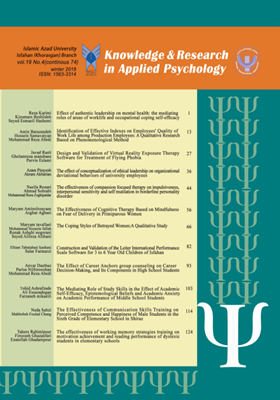The effectiveness of compassion focused therapy on impulsiveness, interpersonal sensitivity and self mutilation in borderline personality disorder
Subject Areas : Educational
Nazila Rezaei
1
,
Ahmad Sohraby
2
,
Mohammad Reza Zoghipaidar
3
![]()
1 - Clinical Psychology, Islamic Azad University of Hamedan, Iran.
2 - Academic member, University of Kurdistan, Iran.
3 - Academic member, University of Bu-Ali Sina, Iran.
Keywords: borderline personality disorder, compassion-focused therapy. impulsiveness, self-mutilation, interpersonal sensitivity,
Abstract :
The aim of this study was to investigate the effectiveness of compassion-based therapy on impulsivity, interpersonal sensitivity and self-harm in people with borderline personality disorder with self-reported history. This research was conducted within the framework of a single subject design with a baseline, with a simultaneous start, in 9 sessions for one hour on five patient follow-up trials. The statistical population in this study was patients with borderline personality disorder, of whom five were identified with the borderline personality disorder and according to volunteering and adapted to the criteria of the study, they were selected through targeted sampling, which was determined according to the diagnosis of a psychiatrist with this disorder. Data were collected through Emotional Intelligence Questionnaire (Bar-On, 1980) and Interpersonal Impulsiveness and Interpersonal Sensitivity subscales. Data analysis by diagram and change coefficient showed that the intervention had significant and significant changes in signs and symptoms of self-mutilation of border patients. Contra-based treatment interventions have been effective on impulsiveness, interpersonal sensitivity, and self-confidence in people with borderline personality disorder.
بنازاده، ح؛ غفارینژاد، ع. (1383). گزارش یک مورد خونآشامی در بیمار مبتلا به اختلال شخصیت مرزی. مجلة دانشگاه علوم پزشکی کرمان، 12(1)، 80-84.
طغیانی، م؛ تاجی، ه.(1389). چکیده پایاننامة تحصیلات تکمیلی سال 1384 دانشگاه آزاد اسلامی واحد خوراسگان. اصفهان: نشر دانشگاه آزاد اسلامی واحد خوراسگان.
علیلو، م؛ شریفی، م. (1391). رفتاردرمانی دیالکتیکی برای اختلال شخصیت مرزی. تهران. نشر ناردیس.
فتحی آشتیانی، ع؛ داستانی، م. (1389). آزمونهای روانشناختی: ارزیابی شخصیت و روان. تهران: بعثت.
نوربالا، ف؛ برجعلی، ا؛ نوربالا، ا. (1392). اثر تعاملی «شفقت به خود» و نشخوار فکری بیماران افسرده در «درمان مبتنی بر شفقت»، ماهنامة علمی- پژوهشی دانشور، 20(104). 77-84.
Atkinson, R. L., Atkinson, R. C., Smith, E. E., Bem, D. J., & Nolen-Hoeksema, S. (2000). Hilgard's Introduction to Psychology. History, Theory, Research, and Applications.
American Psychiatric Association. (2013). Diagnostic and statistical manual of mental disorders (DSM-5).American Psychiatric Pub.
Bennett-Goleman, T. (2002). Emotional alchemy: How the mind can heal the heart. Harmony.
Clarkin, J. F., Levy, K. N., Lenzenweger, M. F., &Kernberg, O. F. (2007).Evaluating three treatments for borderline personality disorder: a multiwave study. American Journal of Psychiatry, 164(6), 922-928.
Gilbert, P., & Andrews, B. (Eds.). (1998). Shame: Interpersonal Behavior, Psychopathology, and Culture. Oxford University Press on Demand.
Gilbert, P., & Procter, S. (2006). Compassionate mind training for people with high shame and self‐criticism: Overview and pilot study of a group therapy approach. Clinical Psychology & Psychotherapy, 13(6), 353-379.
Gilbert, P. (2009). Social mentalities: Internal ‘Social’ conflicts and the role of inner warmth and compassion in cognitive therapy. In p. Gilbert & K.G.Bailey (eds.), Genes on the couch
Gunderson, J. G. (2011). Borderline personality disorder. New England Journal of Medicine, 364(21), 2037-2042.
Kelly, T. M.,Soloff, P. H., Lynch, K. G., Haas, G. L.,& Mann, J. J. (2000). Rcent life events, social adjustment, and suicide attempts in patients with major depression and borderline personality disorder. Journal of Personality Disorder, 14,316-326.
Leary, M. R., Tate, E. B., Adams, C. E., Batts Allen, A., & Hancock, J. (2007). Self-compassion and reactions to unpleasant self-relevant events: the implications of treating oneself kindly. Journal of Personality and Social Psychology, 92(5), 887.
Millon, T. (2004). Masters of the mind: Exploring the story of mental illness from ancient times to the new millennium. John Wiley & Sons.
Neff, K. D. (2003). The development and validation of a scale to measure self-compassion. Self and identity, 2(3), 223-250.
Neff, K. D., &McGehee, P. (2010).Self-compassion and psychological resilience among adolescents and young adults. Self and identity, 9(3), 225-240.
Paris, J. (2005). Borderline personality disorder. Canadian Medical Association Journal, 172(12), 1579-1583.
Pasieczny, N., & Connor, J. (2011). The effectiveness of dialectical behaviour therapy in routine public mental health settings: An Australian controlled trial. Behaviour Research and Therapy, 49(1), 4-10.
Stanley, B. Winchel, R. Molcho, A. Simeon, D, & Stanley M. (1992).Self mutilation: Psychological and biological correlates.American Journal of Psychiatry, 4(2), 149-155.
Salzberg, S. (2002). Lovingkindness: The revolutionary art of happiness. Shambhala Publications.
Soloff, P. H. (2000). Psychopharmacology of borderline personality disorder. Psychiatric Clinics of North America, 23(1), 169-192.
Stiglmayr, C. E., Shapiro, D. A., Stieglitz, R. D., Limberger, M. F., &Bohus, M. (2001).Experience of aversive tension and dissociation in female patients with borderline personality disorder—a controlled study. Journal of Psychiatric Research, 35(2), 111-118.
Young, J. E., Klosko, J. S., &Weishaar, M. E. (2003). Schema therapy: A practitioner's guide. Guilford Press.
_||_

